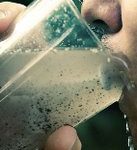On February 20, tap water plants in the city of Yancheng, Jiangsu province, were closed after the water was contaminated by a phenol compound. Large areas of the city, which is home to 200,000 residents, were left without drinking water. The incident reveals serious failings in China’s water management system, and it is worth a closer look.
There is nothing special about Yancheng. A survey of drinking water sources carried out in 2007 by the Jiangsu environment bureau found problems in every single city in the province. Sources of pollutants were identified in 13 of the 18 sources of tap water for the provincial capital, Nanjing, and in seven of eight sources for the city of Wuxi.
Water pollution statistics for the entire country were issued by the China National Environmental Monitoring Centre in June 2006. Drinking water sources were below standard in just over one-in-five key environmental protection cities. Polluted tap water is a direct threat to the health and lives of residents. According to the government, an environmental incident occurs once every two days on average, 70% of which involve water pollution.
Yancheng draws its tap water from rivers that include the Mangshe River. The extraction points are all surrounded by polluting industries. As early as 2003, local media outlets exposed the dangers posed by the 51 industrial firms that are based in or around areas that are supposed to be protected as sources of drinking water. Eleven of those firms were subsequently closed or relocated.
As has happened elsewhere, a cycle of treatment and pollution was set in motion. The city dealt with the heavy polluters near drinking-water sources, yet it still approved the construction of new projects. Many outlets for waste-water were located upstream of water extraction points on the Mangshe River and Xinxianggang River. According to Article 34 of China’s 2002 Water Law, it is illegal to construct sewage outlets in protected drinking water sources. However, in Yancheng, not only were sewage outlets located in protected areas, but also the waste came from very polluting chemical companies, including the polluters in this particular case, Yancheng Biaoxin Chemicals.
After the 2007 algae bloom in Taihu Lake, the State Environmental Protection Administration (now the Ministry of Environmental Protection) and the provincial environment authorities demanded stronger oversight. Yancheng decided to close or relocate at least one-third of key chemical plants that were upstream or near protection areas. The remaining two-thirds were supposed to be dealt with in 2008.
In the meeting that set out the plan, one city leader described the threat from chemical plants as a time bomb threatening water security in Yancheng. He cited a chemical leak at Longfeng Aromatics, strange odours coming from the river in 2004 and 2005 and a waste leak from Anhu Agricultural Chemicals in 2007.
However, one year later Yancheng extended the deadline for closing or relocating 10 of the firms until the end of 2009. These firms included Biaoxin. Indecision and delay meant a serious incident was permitted to happen. On February 20, Biaoxin dumped 30 tonnes of phenol-contaminated effluent into the Mangshe River. The water that reached the tap water plants breached limits on volatile phenols by a factor of 100; 200,000 residents had their water cut off.
This may have been the behaviour of a rogue enterprise, but behind the incident lay weak supervision and enforcement, and a local government that illegally allowed waste outlets to be built near water sources. It is a problem that could have been predicted when dangerous industries were allowed to operate on the river. The locals describe it thus, “keep the rat poison by the stove and something is bound to go wrong.”
Laws have been decreed and policies issued at the highest levels. The environment authorities have put systems in place and launched crackdowns. There is no doubt that water security is an issue that is taken seriously. In practice, however, the environmental authorities are weak. Environmental protection policies are subordinate to the broader economic picture. Environmental impact assessments can be breached if they are a barrier to investment. Once a crackdown has ended, polluting industries can pick up where they left off – as long as it will benefit GDP growth. Faced with the choice between economic growth and protecting water resources, local governments favour the economy. This choice reflects a problem in their understanding of development.
Northern Jiangsu is underdeveloped, and some local governments talk about embracing a rapid, “pole-vault” model of development. Seeking quick economic gains, they have courted profitable, yet polluting, chemical industries. Yancheng has established nine chemical industrial parks.
In northern Jiangsu, chemical industrial parks were in need of tenants; in the south, tougher environmental regulation put pressure on heavily polluting companies. Consequently, a number of firms relocated to the province’s northern coastline.
These movements saw government income in northern Jiangsu rise by 33.9% in 2008, compared to 21.1% for the province as a whole. The majority of subdivisions under the administration of Yancheng city saw their incomes rise by over 40%.
However, an over-reliance on the chemical industry brought environmental pressures. Clean rivers became channels of effluent. In the wake of the Yancheng incident, it is hard not to ask why this was permitted to happen. The area is now covered in chemical industrial parks; even if they are kept away from water sources, what about waste that is released upstream? How do you prevent pollution downstream?
Responding to these questions, a local environmental official told reporters that it is normal to meet basic needs before protecting the environment. An official with the local investment office commented that western countries have shown the feasibility of polluting first and cleaning up later; it is an unavoidable development model, he said. The media summarised his position as, “it is better to be poisoned than poor”.
These views are not unique to Yancheng. Some see environmental problems as the normal consequences of an early stage of economic growth, which will be naturally resolved through further development. However, when pollution is a direct threat to the health and lives of the people, why should we wait? It is mostly the officials – who can afford to drink bottled water, live apart from polluters and eat uncontaminated foods – who think it is best to run the risk of dying. It is vulnerable social groups who suffer most from water and air pollution.
The Chinese central government is aware of the imbalance regarding economic development and environmental protection. The “scientific view of development” was developed in order to achieve balanced and sustainable growth. “It is better to be poisoned than poor” does not fit with the scientific view of development.
The Yancheng incident will spur emergency measures: releasing water from reservoirs to flush out the pollution; finding new water sources; and relocating chemical plants. Similar events have triggered similar reactions in the past. But we must be aware of the limitations of this approach: extra water only dilutes the pollution and washes it downstream; new water sources lead to over-extraction and diminished concerns about local water pollution; the relocation of plants only moves the problem closer to the sea or into rural areas.
If we want to drink clean water, we need to control pollution and stop projects that contaminate our rivers. This requires widespread participation in environmental management and policymaking. Understanding the environmental costs and benefits of various projects will help us find a balance and a negotiated compromise between different interests. We have no time to waste: to protect our water we need a new type of decision-making. It will test the will and the capacity of government at all levels to implement the scientific view of development.
Ma Jun is director of the Institute of Public and Environmental Affairs
Frontpage photo by Woocool

